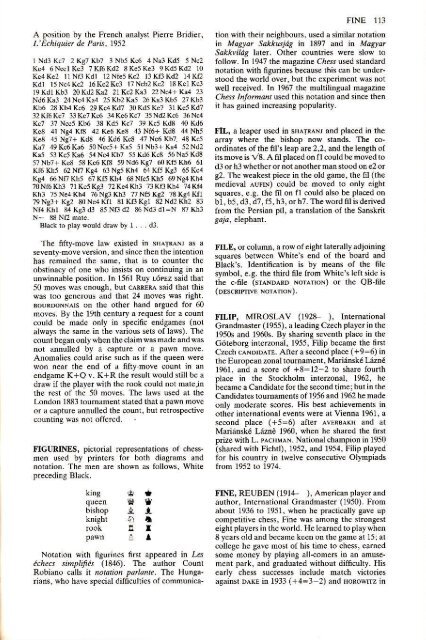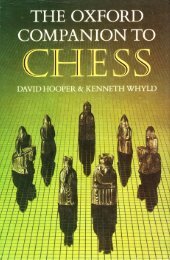Create successful ePaper yourself
Turn your PDF publications into a flip-book with our unique Google optimized e-Paper software.
A posnion bl tne French inalyst Piere Bridier,<br />
L tihiquiel de Pnris,1952<br />
1 Ndr Kc7 2 Kq7 Kb7 3 Nb5 (16 4 Na3 Kd5 i Nc2<br />
(e4 6N.c1Kdl 7K6Kd2 3 Ke5 Ke:l sKdlKd2 10<br />
Kc4Ke2 llNfSKdl 12NL5Kc2 l3(B(d2 14 K1:<br />
Kdl l5Nc4(c2 16Kc2Kc3 lTNctr2Kc2 13Kc1Kc3<br />
19Kdl(b3 20Kd2 Ka2 21Kc2Kal 22 Nc4+ Ka4 I<br />
Nd6Ka3 24Nc4(a1 25Kb2Kai 26Ka3Kb5 27Kb3<br />
Kb6 2,1Khl Kc6 29Kc4Kd7 30Kd5Ke7 31Ke5K'17<br />
32(l6(c? 33K.7K.6 34Kc6Kc7 l5Nd2Kc6 l6Nc4<br />
k7 37 Ncc5 Kb6 33 Kd5 K.7 l9 Kc5 Kd8 40 Kd6<br />
Kc3 4l Nel Kr3 42 Ke6 Ke3 .13 Nf6+ Kd3 ,llNhj<br />
Ken 15 Ng7+ (d3 ,16 Kd6 Kc3 47 Ne6 Kb7. 43 Kd<br />
(a? 49K.6Ka6 50Nec5+Ka5 5rNb3+Ka4 52Nd2<br />
Kas 53Kc5Ka6 54Nc4Kt7 55(d6Kla 56Na5(d3<br />
57Nb7+Ke3 53KC6KI3 59Nd6Kg7 60 Kl5 Kh6 6l<br />
KI6 K115 62NflKg4 6:lNe5Kh4 KI5Ks3 65 Kc1<br />
Kg1 66Nfi(h5 67 Kls Kh4 63NIciKhr- 69Ng4Kh4<br />
70Nl6Kh3 71(c5Kg3 72K.4Kh3 73KBKh4 74Kr'1<br />
Kh3 75Ne1Kh4 76NerKh3 77Nfsxs2 73Kg4K1<br />
79Ng:r+ Ke2 80 Ne.1Kl1 3lXJ3Ke1 32Nd2Kh2 3l<br />
Nt4Khl 84(s3d3 35Nf3d2 36Ndrdl=N ri7 Kh3<br />
FINE 1]3<br />
tion with then neighbouB. used a sinil.r nolalion<br />
in Magtar Sakk6jnE in 189? and in Mag.rar<br />
Sakkribq latet. Other countnes were slow ro<br />
Iollow.In 1947 the magazine Cr.$ used slandard<br />
notation Rnh figunnesbecause rhiscan be mdeF<br />
s<strong>to</strong>od fte world over, bnt the experimeot was.ot<br />
well received. ln 1967 the multilingual m.gdine<br />
Clcsr /nlalha,, used this nor.tion and since then<br />
it has gained inoeasing popularity.<br />
FiL, a leaper used ii snarRANJ and plaad in the<br />
array whcre lhe bishop now slands. Tbe m-<br />
ordinates oflhe 6l\ leap are2,2,.nd lhe lengthol<br />
itsnoveis V8. A fil plaed on ll couldbemoled<strong>to</strong><br />
d3orh3whcthcror notanolhernans<strong>to</strong>od on e2 or<br />
a2. lhc Neakestpiecein the oldsane, rhe m (the<br />
medieval ^unN)<br />
ould be noled io only eishl<br />
squares, e.8. the lil on fl .ould also be placed on<br />
b I, b5 - d3, d7, f5, h3. o. h7. <strong>The</strong> word Iil is denved<br />
liom thc Pcmian pil, a translation oi tbe S.nskril<br />
Blr.k ro play {ould d.aw <strong>by</strong> L . d3<br />
seventy moveversio., and since then the inkntion<br />
h,s rcrained tbe sane. that is !o @unler thc<br />
obstinacy ol one wbo insisis on continuine in an<br />
unwinnable position. In 156l Ruy r6ptz said tbat<br />
50 noles was cnough, but GiEM said th.t tbn<br />
Nas 1oo geDerous and $at 2,1 noves was right.<br />
lhe olher hand argued for 60<br />
moves. By tbe 191h century a request ior a counl<br />
could be oade only nr speciic endeames (nor<br />
,lways rhc same in the vanous sets otlawr. T1'e<br />
couni began only when the claim was made aad sB<br />
not anduled <strong>by</strong> r capture or a pawn move<br />
Anomalies @uld arise such as il lhe queed were<br />
*on near rhe end of a fift! nove count in an<br />
eDdgane K+Q !. K+R the resuhwouldstill be a<br />
dras iithe playersith the rook could not nalejn<br />
rhe rest ol thc 50 moves. Tbe laws used at the<br />
London 1883 rournament sta ted that a pas n move<br />
or a capture antrulled the count. but reirospedive<br />
.ounting was nor oficrcd.<br />
FIGURINES, piclond repiesentalions of chcssnen<br />
used <strong>by</strong> printere for both diagrans and<br />
notation. <strong>The</strong> men are shown as lollows. White<br />
g<br />
l. ,t II<br />
Notation with llgurincs lint appeared in aes<br />
tchecs simptiliis (1846). Tte aurhor counl<br />
Robiano calls ir natition pdrlunte. <strong>The</strong> Hnne -<br />
rians, who hale special dilliculrics of communica-<br />
F[LE, orcolunn, arowoleight laterallyadjoining<br />
squares betNccn While s end of the board and<br />
Blacks. IdeDtincation is <strong>by</strong> means of the 6lc<br />
symbol. e.g. ihe rhid file lron whilc\ lelt side is<br />
the c-6te GTANDARD NorAroN) o. the QB-6le<br />
(DEscRrmr No no0.<br />
FILIP, MIROSLAV (1928 ), Inlernaional<br />
Grandmaste. (1955), aleadins Czech playerin the<br />
1950s and 1960s. By sharing *venth ptace in the<br />
Gdteborg intcrzonal. 1955, Filip became the fsl<br />
Czcch CAND,D^TE. Aliei a se@nd placc (+9=6) i.<br />
the Europeanzonaliournamcnt. Marinnsk6 Lizn€<br />
1961. and a score of +8:12 2 <strong>to</strong> share lourtb<br />
place in thc Srockholm inlerzonal, 1962, he<br />
became a Candidate for the econdtime; bul in tne<br />
candidares rouminenh of 1956 and 1962 he made<br />
only nodeiate scores. His besl achievements in<br />
drher inrernalional events were al Vienna 1961- a<br />
sc.ond place (+5-6) ailer Av.RBAx,r and at<br />
Maninsk6 Lrzn6 1960. when he shared lhe 6rst<br />
prize with l-. pAcnMAN. Nadonal chinpion in 1950<br />
Ghared sith Fichtl). 1952, and 195,1, Filip playcd<br />
for his counrry in twelve consecutive Olympiads<br />
FINE, REUBEN (1914 ). American pla],crard<br />
aulhor. lnrci,rational Graodnaste. (1950). Fron<br />
about 1936 <strong>to</strong> 1951. when he practicall! gale up<br />
compedrile <strong>chess</strong>, Fine Nas among the slrongest<br />
eightplayets h thc world. He learned<strong>to</strong>playwhen<br />
8 yea6 old and became keen on lhe gane at 15iat<br />
colLege he gale nost othis time 10 <strong>chess</strong>. canrcd<br />
sone money <strong>by</strong> playnre all-comers in an anusemcnt<br />
park. and graduaied $ilhout diliculty. His<br />
early <strong>chess</strong> successes include natch vicrones<br />
asainn DAc in 1933 (+4=3 2) and noRoslrz id




